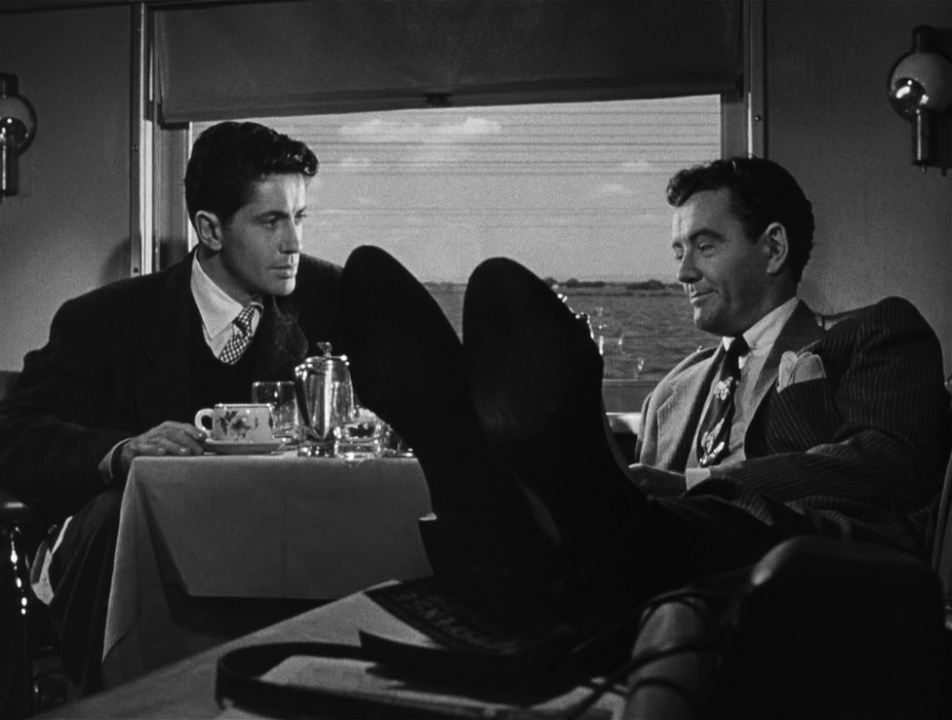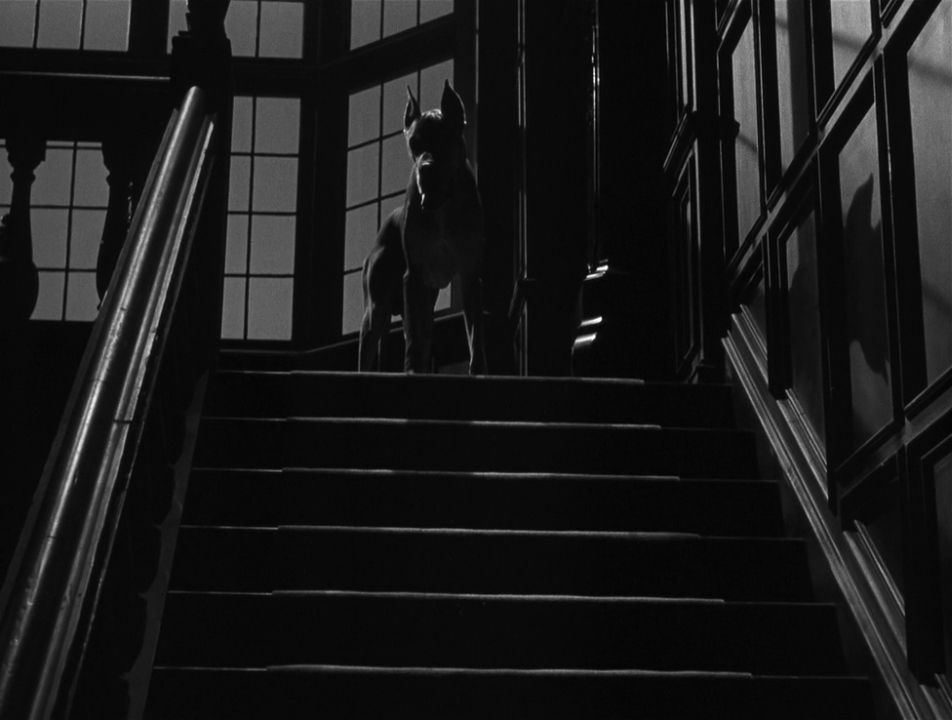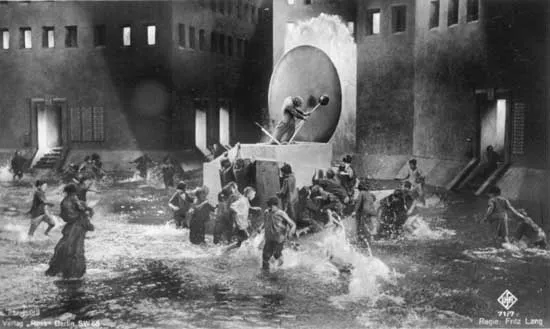| Daniel McCabe |

The titular meeting in Strangers on a Train
Strangers on a Train plays at the Trylon Cinema from Sunday, April 7th, through Tuesday, April 9th. Visit trylon.org for tickets and more information.
Strangers on a Train (1951) comes from the darkness, and not only because Alfred Hitchcock (1899-1980) shot the film in black and white. It draws influences from the German Expressionist films of the 1920s to create a foreboding mood while using the conventions of classic Hollywood to bond with the audiences of the day. In many ways, Strangers on a Train stands as a fulcrum between Hitchcock’s early work and his later filmography.
That may seem like high praise for one of Hitchcock’s lesser-known works. However, every time I watch Strangers on a Train, it reminds me of both Hitchcock’s earlier films such as Rebecca (1940), and his later films like Psycho (1960). My answer to why it seems so well placed in Hitchcock’s evolution as a filmmaker has to do with what the film does with the styles that influenced the Master of Suspense.
Before I go further, keep in mind that I will describe key plot points and scenes from Strangers on a Train. While the film turns 73 this year, it hasn’t been embedded into our shared cultural language like some other Hitchcock films. We’re not talking about the shower scene in Psycho (1960), after all.
By 1951, Alfred Hitchcock had worked in Hollywood for almost twelve years. However, he remained very much a European director with continental influences, in contrast to many of his American contemporaries who came up in the old studio system. Two scenes in particular showcase these influences on Strangers on a Train. One recalls the gothic horror of F.W. Murnau (1888-1931), and the other makes me think of the brutal action sequences of Fritz Lang (1890-1976).

The Interior of the Antony Mansion in Strangers on a Train.
In 1924, Hitchcock visited the set of the silent classic The Last Laugh (1924). There, F.W. Murnau personally showed Hitchcock how to use the contrast between shadow and light to create a dark, enigmatic mood.1 Hitchcock was fortunate to have the opportunity to learn from an established filmmaker, but I’m sure neither one knew that a century later, people would still be writing about their encounter.
Murnau had used the binary of light and shadow to great effect in his earlier, and perhaps best-known film, Nosferatu (1922). Roger Ebert once wrote of Nosferatu, “I admire it more for its artistry and ideas, its atmosphere and images, than for its ability to manipulate my emotions like a skillful modern horror film.”2
I agree that Murnau’s “Symphony of Horror” is not scary by modern standards. There’s a creepiness to it, but it doesn’t have the same impact today that it would have had on audiences a century ago. Still, Nosferatu remains an important film because it contains the building blocks of cinematic suspense and terror that many subsequent classics reference. We can see this in Strangers on a Train during the scene where Guy (Farley Granger) sneaks into the Antony mansion.

Meeting the vampire for the first time in F.W. Murnau’s Nosferatu.
In Nosferatu, when Hutter (Gustav von Wangerheim) first arrives at the castle of Count Orlock (Max Shreck), Murnau filters the scene to trick the viewer’s eye into believing that there is a moonlit courtyard. Out of the shadows, Count Orlock appears. Hutter doesn’t know that Count Orlock is the “Nosferatu” of the film’s title. Much like Guy Haines in Strangers on a Train, Hutter isn’t exactly a genius. However, Murnau has carefully laid the groundwork for the viewer to know that Orlock is a monster. The effect of him emerging from the shadows, clad in black, remains one of the most iconic scenes from Nosferatu.
Hitchcock uses a similar effect in Strangers on a Train. When Guy sneaks into the Antony Mansion, moonlight shines in through the windows. At the top of the stairs stands a dog, waiting to alert the household of Guy’s presence. The way that Hitchcock frames the shot emphasizes the dog’s threat like Murnau did with his vampire in Nosferatu.
While Murnau uses this technique of contrasting light and shadow to introduce his titular villain, Hitchcock uses it for a different purpose. Guy moves past the dog with relative ease, but just for a moment, the viewer thinks it will bark and wake up the entire house. This elevates the tension in the scene and keeps the audience transfixed. The dog is a red herring, and it’s not the same as introducing a creature whose “name sounds like the call of the death bird at midnight.” Even so, Hitchcock wants to keep the audience guessing, and in that view, the dog scene is effective because it’s staged in the same manner as the introduction of a major villain might be.

The climactic carousel scene from Strangers on a Train.
When Hitchcock began working in Hollywood in 1939, the model for a successful European director making it big in America had been established by Fritz Lang. Lang’s first Hollywood film, Fury (1934), was a major critical and commercial success, and one of the first examples of film noir. Hitchcock admired Lang, and you can see the uncompromising brutality of Lang’s work in the climax of Strangers on a Train.
When I consider Lang’s films, the first element that comes to mind is the way he used familiar architectural elements as backdrops for effective action set pieces. Take, for instance, the scene in M (1931) where the killer (played by Peter Lorre) is thrown down the stairs by his accusers, or the scene in Metropolis (1927) where the children of the underground are grasping for safety through a flood of water. I should note that Lang had Lorre throw himself down the stairs multiple times and the water in the Metropolis flood scene was freezing. He wasn’t exactly known for protecting the safety of his actors.

Children escaping the flooded underground in Fritz Lang’s Metropolis
The spiritual successor of Lang’s intensity is the carousel scene at the end of Strangers on a Train. The chaos of the scene contrasts starkly with the most ordered of carnival rides. When you think about a carousel, after all, you think of a ride safe and slow enough for toddlers to enjoy. However, in Strangers on a Train, an out-of-control carousel is the setting of a climactic fistfight between Guy and Bruno (Robert Walker).
To create a sense of chaos, Hitchcock uses a series of quick cuts between the out-of-control carnival ride, the fistfight, and screaming children. Like Fritz Lang did in many of his films, Hitchcock contrasts a familiar architectural element with brutality to generate an effective action scene. However, the quick cuts take this technique a step further than Lang’s early work, creating a quintessential Hitchcock climax. He used this technique to great effect in the finales of North by Northwest (1959) and Vertigo (1958).
By looking at Hitchcock’s films through the lens of his influences, you can see the development of the motion picture as an art form. Thinking about how one filmmaker’s work informed subsequent directors is like participating in a great conversation that has been going on for over a century. We’ll never know what F.W. Murnau and Alfred Hitchcock talked about on set in 1924, or what Fritz Lang and Hitchcock might have discussed if they ran into each other on Hollywood Boulevard in the 1940s. However, by examining how Murnau and Lang’s films influenced Hitchcock, perhaps we can imagine it.
References
1 White, Edward. The Twelve Lives of Alfred Hitchcock: An Anatomy of the Master of Suspense. New York: W.W. Norton & Company, 2021. 28.
2 Ebert, Roger. The Great Movies. New York: Broadway Books, 2002. 332.
Edited by Olga Tchepikova-Treon
